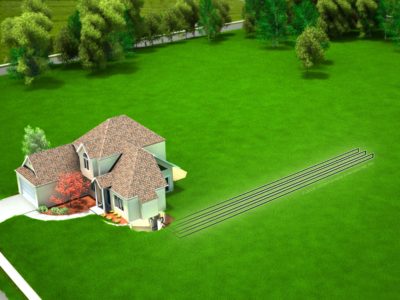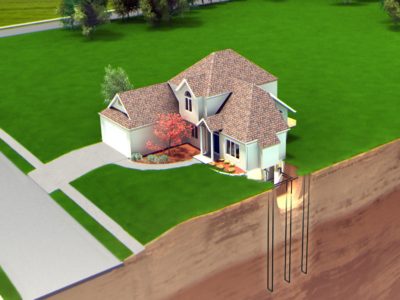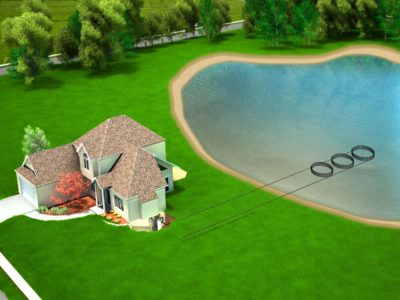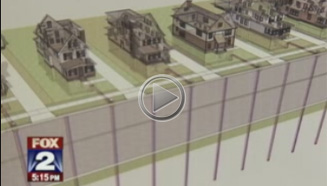ENERGY FROM EARTH’S BIGGEST POWER SOURCE: THE EARTH ITSELF.
Heating and cooling accounts for about 45 percent of your energy bill. The federal government estimates that the average homeowner spends more than $10,000 for heating and cooling over a ten year period. A Geothermal system can dramatically reduce your heating and cooling utility bills.
There’s an invaluable energy source buried right in your own backyard: the earth itself. Forget oil or gas, geothermal systems tap into the relatively consistent temperatures of your yard, pond or well. This ingenious technology runs on electricity but uses the earth’s thermal energy to pre-condition refrigerant used to heat and cool your home so you can enjoy higher energy efficiency inside – no matter how extreme the weather gets outside.
Used where adequate land is available, horizontal loops involve one or more trenches that are dug using a backhoe or chain trencher. High density polyethylene pipes are inserted, and the trenches are backfilled. A typical home requires 1/4 to 3/4 of an acre for the trenches.
Vertical loops are used when space is limited. Holes are bored using a drilling rig, and a pair of pipes with special u-bend fittings is inserted into the holes. A typical home requires three to five bores with about a 15-foot separation between the holes.
How does geothermal work?
Ground source heat pumps work by circulating water or a water/antifreeze solution through a closed loop of polyethylene pipe that is buried in the ground or set beneath the water. GSHP systems can be laid out in different orientations, depending on the situation. A closed loop system, the most popular, can be laid out either vertically in 50 -250 foot deep holes drilled like a well, or horizontally in 3-6 foot deep trenches. The less common open loop system circulates a constant source of ground water and dispels the water back to its origin, such as a stream, well, or pond.
Summer – geothermal systems take heat from the structure, transfer the heat to refrigerant in the continuous loop tubing, where it is cooled by the 50 degree temperature of the earth and returned via the duct system or radiant floor heating.
Winter – geothermal systems absorb heat from the from the earth, transfer that heat to a refrigerant in the continuous loop tubing, then a compressor increases the temperature and the warm air is returned via the duct system or radiant floor heating.
Geothermal in Wyandotte, Michigan
Cappy Heating & Air Conditioning is awarded the contract for the city of Wyandotte Geothermal Project. Wyandotte, Michigan, strives to be a city where homes are heated and cooled using geothermal energy systems. Estimated savings are significant, $500 to $1000 a year. Geothermal is a “green” technology. The environment benefits by reduced energy demands, especially in hot weather.
Click here to view press release .
Geothermal Incentives
Get Help Funding Your WaterFurnace Installation
Installing a WaterFurnace geothermal system can dramatically reduce the cost of heating, cooling, and providing domestic hot water for your home. If you’re anything like your Michigan neighbors, though, it’s getting past the initial installation cost that’s difficult. Don’t worry. There’s help. It comes in the form of various federal, state, and local financial incentives. Now through 2021, the federal tax credit is available but is scheduled to gradually decrease each year. The credit started at 30% through 2019 and has dropped to 26% through 2020, and will drop again to 22% in 2021, so act now for the most savings!

Questions about what incentives might be available for you at the state and local level? Check out DSIRE, a free, open, and comprehensive resource providing state-by-state information on thousands of policies and incentives promoting renewable energy and energy efficiency. Established in 1995 and funded by the U.S. Department of Energy, DSIRE is an ongoing project of the N.C. Solar Center and the Interstate Renewable Energy Council.
Economical – provides operating cost savings of 30 percent to 60 percent
Earth Friendly – uses the renewable thermal energy of the earth
Comfortable – maintains an even temperature and humidity level throughout your home
Safe – no open flames, no fumes, no soot
Flexible – one single unit handles heating, cooling, and water heating
Dependable – contains few moving parts and no outdoor equipment, requiring little maintenance
Value – increases the value of your home by decreasing your heating and cooling bill; generally produces higher cash flow
Efficiency – as much as four times as efficient as conventional systems
Do you have a Geothermal project in mind?
Call Cappy Heating & Air Conditioning (734) 655-1360 and ask for Jeff Caplan, Michigan’s Own Geothermal Expert or fill out our contact form below:





